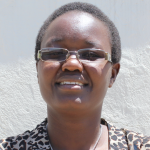Kapsotik Secondary School can't provide enough water to serve its 579 students and 19 staff members. The school currently has a few rainwater tanks installed with pipes running to the kitchen and some standpipes meant for handwashing, but as the population has grown and rains have decreased, more and more often these tanks and pipes run empty.
This leaves students bringing water to school and going out to fetch it during lunchtime. The closest spring is still far away and difficult to access. Even the cleanest portions of the stream are brown and riddled with algae. But the students have no option but to brave the rocky, hilly path and drink the contaminated water each day.

Principal James Chembu (in the below photo, in front of one of the school's empty rain tanks) explained how the water crises affects him. "Survival in school is difficult because of lack of water. I cannot manage to run a school with teachers and students who cannot have access to clean water. This affects me a lot because they look up to me to ensure that they have water in school."

The most telling aspect of this situation, as school administrators told us, is that as soon as the water from the rain tanks runs dry, students lose momentum in their studies, including those who are usually their best students. This shows that it's not for a lack of trying that students' performance suffers. It's drinking the dirty water and making the long, arduous journey to fetch it multiple times per day.

"Lack of water in school has affected my health and my academic performance," 15-year-old Michel M said (she's in the above picture, fetching water at the spring). "This is because most of the time, [I] am sick and this forces me to miss classes."
With a new well on school grounds, students will be able to use their energy on studying. They will no longer suffer from draining illnesses or miss class time trekking through the forest.
What We Can Do:
New Well
We conducted a hydrogeological survey at this school and the results indicated the water table beneath it is an ideal candidate for a borehole well. Due to a borehole well's unique ability to tap into a safe, year-round water column, it will be poised to serve all of the water needs for this school's large population, even through the dry months.
The school will help collect the needed construction materials such as sand, rocks, and water for mixing cement. They will also provide housing and meals for the work team, in addition to providing local laborers. We will complement their materials by providing an expert team of artisans and drilling professionals, tools, hardware, and the hand-pump. Once finished, water from the well will then be used by the school’s students and staff for drinking, handwashing, cooking, cleaning, and much more.
Handwashing Stations
There is currently nowhere for students to wash their hands after using the latrines or before eating lunch, let alone the water to do so.
The student health club will oversee the two new handwashing stations we will provide, and make sure they are kept clean and in working condition. The club leaders will fill the handwashing stations with water daily and make sure they are always supplied with a cleaning agent such as soap or ash.
VIP Latrines
We will construct two triple-door latrine blocks using local materials that the school will help gather. Three doors will serve the girls and three doors will serve the boys. All of these new latrines will have cement floors that are designed to be easy to use and to clean. And with a borehole right on school property, there should be enough water to keep them clean.
Training on Health, Hygiene, COVID-19, and More
We will hold a one-day intensive training session with students, teachers, and parents. This training will cover a wide range of topics including COVID-19 symptoms, transmission routes, and prevention; personal and environmental hygiene; and the operation and maintenance of the borehole, latrines, and handwashing stations. There will be a special emphasis on handwashing.
Our team of facilitators will use a variety of methods to train, including participatory hygiene and sanitation transformation, and asset-based community development. We will initiate a student health club, which will prepare students to lead other pupils into healthy habits at school and at home. We will also lead lectures, group discussions, and provide illustrative handouts to teach health topics and ways to promote good hygiene practices within the school including handwashing and water treatment. We will then conduct a series of follow-up trainings before transitioning to our regularly scheduled support visits throughout the year.
We and the school strongly believe that all of these components will work together to improve standards at this school, which will help lead to better student academic performance and will help unlock the opportunity for these students to live better, healthier lives.

 Borehole Well and Hand Pump
Borehole Well and Hand Pump
 Rehabilitation Project
Rehabilitation Project





































